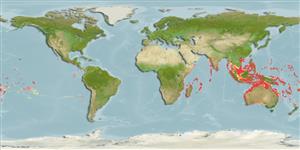Environment: milieu / climate zone / depth range / distribution range
นิเวศวิทยา
เกี่ยวกับทะเล,น้ำเค็ม เกี่ยวกับหินโสโครก; ระดับความลึก 20 - 350 m (Ref. 58488). Tropical; 20°N - 36°S
Indo-Pacific: Red Sea and South Africa (Ref. 4326) to Japan, Australia, and New Zealand. One specimen from Rapa (Ref. 4326).
ขนาด / น้ำหนัก / Age
Maturity: Lm ? range ? - ? cm
Max length : 40.0 cm TL เพศผู้/กระเทย; (Ref. 9710)
เงี่ยงครีบหลัง (รวม): 9; ก้านครีบอ่อนที่หาง (รวม): 12; เงี่ยงครีบก้น 3; ก้านครีบอ่อนที่ก้น: 9. Body deep blue in color with a yellow band from snout through eye and along back to caudal fin (Ref. 4326).
Inhabits caves and crevices in rocky reefs (Ref. 9710). Skin contains grammistin which imparts a bitter taste. The amount of toxin produced increases when the fish is frightened (Ref. 4326). Minimum depth reported taken from Ref. 09710.
Life cycle and mating behavior
วัยเจริญพันธุ์ | การสืบพันธุ์ | การวางไข่ | เซลสืบพันธ์ของเพศเมีย(ไข่) | ความดกของไข่ | ตัวอ่อน
Randall, J.E., 1986. Grammistidae. p. 537-538. In M.M. Smith and P.C. Heemstra (eds.) Smiths' sea fishes. Springer-Verlag, Berlin. (Ref. 4326)
IUCN Red List Status (Ref. 130435)
Threat to humans
Poisonous to eat (Ref. 4326)
Human uses
ข้อมูลเพิ่มเติม
ชื่อสามัญชื่อพ้องกลไกการเผาผลาญพลังงานผู้ล่าการศึกษาเกี่ยวกับผลกระทบของสารประกอบทางเคมีที่เป็นอันตรายต่อสิ่งมีชีวิต ประชากร และสิ่งแวดล้อมการสืบพันธุ์วัยเจริญพันธุ์การวางไข่การรวมกลุ่มวางไข่ความดกของไข่เซลสืบพันธ์ของเพศเมีย(ไข่)Egg development
อ้างอิงการเพาะเลี้ยงสัตว์น้ำประวัติการเพาะเลี้ยงสัตว์น้ำสายพันธุ์พันธุศาสตร์ElectrophoresesอัตราพันธุกรรมโรคการแปรรูปNutrientsMass conversion
ผู้ร่วมมือรูปภาพหลายรูปStamps, Coins Misc.เสียงปลามีพิษ เช่น ปลาปักเป้าความเร็วรูปแบบการว่ายน้ำพื้นที่เหงือกOtolithsสมองวิสัยทัศน์
เครื่องมือ
Special reports
Download XML
แหล่งที่มาจากอินเตอร์เน็ต
Estimates based on models
Preferred temperature (Ref.
123201): 15.9 - 28, mean 24 °C (based on 739 cells).
Phylogenetic diversity index (Ref.
82804): PD
50 = 1.0000 [Uniqueness, from 0.5 = low to 2.0 = high].
Bayesian length-weight: a=0.01122 (0.00514 - 0.02450), b=3.04 (2.87 - 3.21), in cm total length, based on all LWR estimates for this body shape (Ref.
93245).
ระดับชั้นอาหาร (Ref.
69278): 4.0 ±0.65 se; based on food items.
Fishing Vulnerability (Ref.
59153): Low to moderate vulnerability (30 of 100).
Nutrients (Ref.
124155): Calcium = 34.6 [21.0, 66.8] mg/100g; Iron = 0.504 [0.266, 0.823] mg/100g; Protein = 18.5 [16.7, 20.2] %; Omega3 = 0.184 [0.120, 0.287] g/100g; Selenium = 46.5 [27.0, 79.1] μg/100g; VitaminA = 98.1 [35.0, 315.1] μg/100g; Zinc = 0.993 [0.688, 1.405] mg/100g (wet weight);
